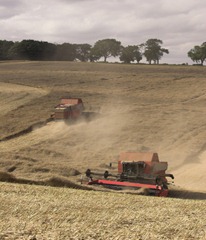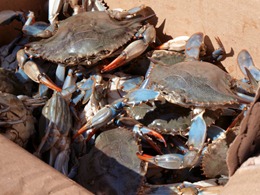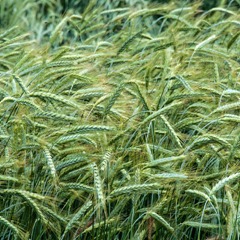Gag or Starve? Poison the Water or Run Out of Food? Other Choices
 That’s the argument: if we don’t use the kind of farming methods that produce a lot of extra bushels per acre, the next three billion people who will crowd the world by the end of this century won’t have enough to eat. But continue to use those farming methods and there won’t be enough topsoil to grow a dandelion and there won’t be any water worth drinking.
That’s the argument: if we don’t use the kind of farming methods that produce a lot of extra bushels per acre, the next three billion people who will crowd the world by the end of this century won’t have enough to eat. But continue to use those farming methods and there won’t be enough topsoil to grow a dandelion and there won’t be any water worth drinking.
It’s not only the Third World that’s finding its drinking water smelling bad and rife with bacteria; it’s American towns and American homes in farm country that find their water is making them sick. In California, 15 per cent of the wells in agricultural areas are contaminated, exceeding the federal contaminant levels for chemicals or bacteria, or both.
There are several sources for this problem: there’s too much manure to begin with, produced by thousands of animals in giant factory farms; there is ground-up animal waste from slaughter houses that kill the factory farm animals that’s spread over farm fields; there is the intense use of fertilizers that are used to make the vast single-crop fields with their exhausted soils produce yet another crop; there are the pesticides sprayed on the crops in great part because most of the pests’ natural enemies are gone, killed by the pesticides along with the pests.
The problem isn’t merely local. The 800-square-mile “dead zone” in the Gulf of Mexico that grows in the summer, shrinks in the winter, but never disappears, has been traced to runoff from the farms along the great rivers that feed into the Mississippi. This runoff flows down the big river directly into the Gulf and feeds the plankton which multiply in huge numbers. When they die and rot, they deoxygenate the water and kill all aquatic life in the zone.
 Before Chesapeake Bay was subjected to both farm and urban runoff, the Bay’s seafood was famous for its size and quality. In Colonial times, giant Bay oysters the size of plates were a famous delicacy that people would travel to eat. Oysters and blue crabs supported a large local fishing industry. But in the Seventies, the Bay had the dubious honor of being the first body of water to have an identified marine dead zone. As the supply of oysters, crabs and fish has shrunk to a tenth of its former size, the Bay community has tried to stem the sources. Farm runoff is a big source.
Before Chesapeake Bay was subjected to both farm and urban runoff, the Bay’s seafood was famous for its size and quality. In Colonial times, giant Bay oysters the size of plates were a famous delicacy that people would travel to eat. Oysters and blue crabs supported a large local fishing industry. But in the Seventies, the Bay had the dubious honor of being the first body of water to have an identified marine dead zone. As the supply of oysters, crabs and fish has shrunk to a tenth of its former size, the Bay community has tried to stem the sources. Farm runoff is a big source.
Controlling farm runoff is a gargantuan problem, not least of which is the combination of the importance of farming and the sacredness of farming as an American institution. But the biggest block to improving the situation is the farm lobby; giant agribusiness companies that control most of the farms because they are the primary buyers the farms produce. As soon as the Environmental Protection Agency proposes a regulation that would require, for example, that less manure or animal waste be spread on fields to reduce runoff, the industry swings into action and gets the regulation shelved or watered down (no pun intended).
Part of the problem is the nature of what modern farming has become. Fields are devoted year after year to a single crop, so that the soil never recovers and gets a chance to restore the minerals that crop needs.This is particularly true of such major crops as corn, which is increasingly grown to produce ethanol rather than food or feed; and soybeans, half of which is grown for oil and the other half for animal feed; and wheat, most of which is used for food. As the fields are repeatedly tilled and harvested with heavy equipment, the repeated tillage and the weight of the equipment compact the soil, decreasing water absorption, discouraging root growth, and increasing runoff. Some three quarters of all farmed acreage suffers from these problems to a greater or lesser degree.
 Clean water or a full silo are not the only choices. The solutions require a change in the way American farms operate. Crop rotation – growing successively different crops that require different nutrients – and letting fields lie fallow to restore themselves is one option. No-till farming, where the soil is only lightly tilled where the field is seeded, instead of turning over the entire field every time a crop is planted is another. Small farmers are finding that learning how to use different techniques can work economically as well as ecologically, but until the giant farms controlled by the large companies are forced to adopt better practices by tighter regulation, the problem of farm runoff will continue to despoil our water, and the quality of American life.
Clean water or a full silo are not the only choices. The solutions require a change in the way American farms operate. Crop rotation – growing successively different crops that require different nutrients – and letting fields lie fallow to restore themselves is one option. No-till farming, where the soil is only lightly tilled where the field is seeded, instead of turning over the entire field every time a crop is planted is another. Small farmers are finding that learning how to use different techniques can work economically as well as ecologically, but until the giant farms controlled by the large companies are forced to adopt better practices by tighter regulation, the problem of farm runoff will continue to despoil our water, and the quality of American life.


